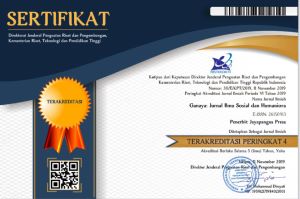Suatu Dilema Identitas Soisal Pada Pemakaian Warna Sepu’ Dalam Upacara Adat di Toraja
DOI:
https://doi.org/10.37329/ganaya.v5i3.1920Keywords:
Social Identity Dilemma, Color Sepu’, Traditional CeremoniesAbstract
This research is backgrounded by the fact that the use of the color sepu' as a marker of social identity for the Toraja people is no longer seen from the greatness of a person or a family, its use is also no longer seen where the tongkonan came from or from which descendants came from or were born, but the most important thing is how big a party can be done. The purpose of this study is to see the dilemma of social identity that occurs in the use of sepu' color in the implementation of traditional ceremonies in Toraja. This paper will use Jenkis' theory of social identity to see the dilemma of social identity that occurs. The method used is a qualitative method with a descriptive approach. Data collection was carried out through literature studies and interviews, the results showed that there was a dilemma of wearing colors on sepu' in traditional ceremonial activities in Toraja that occurred from the side of the person who carried out the traditional ceremonial activities, namely from people who had a middle social class and even the lower class (tana' karurung and tana' kua-kua). The conclusion of the social identity dilemma that occurs in the use of the color sepu' is due to the factors of modernity, religious factors and the biggest is because society has experienced economic development so that it has a lot of wealth which in the end irresponsibly uses the color sepu' which should not be used. However, in all the efforts that society tries to make in order to let go of the social strata, the social strata that are actually owned and inherited will not be forgotten.
References
Arianti, I., Nurlela, & Junaeda, S. (2021). Pergeseran Nilai dan Makna Budaya Tradisi Rambu Solo’ Masyarakat Toraja di Masa Modern. ALLIRI: Journal Of Anthropology, Vol. 3 (2), 62–70.
Berger, P. L., & Luckmann, T. (1990). Tafsir Sosial Atas Kenyataan: Risalah tentang Sosiologi Pengetahuan. Jakarta: LP3ES.
Dillistone, F. W. (2006). Daya Kekuatan Simbol: The Power Of Symbol. Yogyakarta: Kanisius.
Firth, R. (2011). Symbols: Public and Private. New York: Routledge.
Hasni, H., Nur, M. I., Fauziah, N., & Purwanto, A. Dilema Identitas Kebudayaan Dalam Tradisi Ma’tinggoro Tedong Ala Suku Toraja Di Era Turistifikasi. Jurnal Sosialisasi: Jurnal Hasil Pemikiran, Penelitian dan Pengembangan Keilmuan Sosiologi Pendidikan, 7-15.
Jenkins, R. (2008). Social Identity (3rd ed.). New York: Routledge.
Kobong, T. (1992). Aluk, adat, dan kebudayaan Toraja dalam perjumpaannya dengan Injil. Pusbang, Badan Pekerja Sinode, Gereja Toraja.
Kobong, Theodorus. (2021). INJIL dan TONGKONAN: Inkarnasi, Kontekstualisasi, Transformasi. Jakarta: BPK Gunung Mulia.
Kristanto, & Mangolo, Y. (2018). Aluk Todolo Versus Kristen. KINAA: Jurnal Teologi, Vol.3 (1), 1–10.
Liliweri, A. (2007). Makna Budaya dalam Komunikasi Antarbudaya. Yogyakarta: LKiS.
Nattye, P. (2021). TORAJA: Ada Apa Dengan Kematian? (B. Tallulembang, Ed.). Yogyakarta: Gunung Sopai.
Parimba, J. (2021). Rasionalitas Komunikasi Sebagai Pilihan Gereja Dalam Melawan Politik Uang Di Toraja. Melo: Jurnal Studi Agama-agama, 1(1), 49-63.
Sampeasang, A. K. (2018). Tana'dalam Rampanan Kapa': Suatu Tinjauan Teologis Sosiologis Mengenai Makna Tana’Dalam Aluk Rampanan Kapa’dan Implikasi Bagi Keutuhan Keluarga Kristen di Jemaat Suloara’. KINAA: Jurnal Teologi, 3(2).
Sarto, I. (2020). Rambu Tuka’ Sebagai Pemersatu Empat Kasta di Toraja. Jurnal Sipatokkong BPSDM Sulawesi Selatan, 4 (1), 307–311.
SJ, J. W. M. B. (1984). Filsafat Kebudayaan: Sebuah Pengantar. Yogyakarta: PT. Kanisius.
Stets, J. E., & Burke, P. J. (1998). Identity Theory And Social Identity Theory. Washington: Pullman: Depertemen Sociology.
Suhandra, I. R. (2019). Studi Komparatif Makna Konotasi Warna dalam Budaya Masyarakat barat dan Masyarakat Suku Sasak Lombok Indonesia. Cordova Jurnal: Lenguages and Culture Studies, 9 (1), 17–38.
Sumiaty. (2020). Makna Simbolik Tau-Tau dalam Ritual Rambu Solo’ bagi Masyarakat Toraja. In B. J. Pakpahan (Ed.), Teologi Kontekstual dan Kearifan Lokal Toraja. Jakarta: BPK Gunung Mulia.
Susetyo, D. B. (2002). Krisis Identitas Etnis Cina di Indonesia. Psikodimensia-Kajian Ilmiah Psikologo, 2, Tahirs, J. P. (2021). Analisis Perhitungan Perputaran Modal Kerja Usaha Sepu. Journal of Innovation Research and Knowledge, 1(5), 895-902.
Tangdilintin, L. T. (1981). TORAJA dan KEBUDAYAANNYA. Tana Toraja: Yayasan Lepongan Bulan.
Timbang, Y. F. T. (2020). Makna Pengorbanan Babi dalam Ritual Tradisional Toraja. In B. J. Pakpahan (Ed.), Teologi Kontekstual dan Kearifan Lokal Toraja. Jakarta: BPK Gunung Mulia.
Tolan, F. M. (2016). Keragaman Makna Di Balik Sepu’ Bagi Orang Toraja Di Salatiga (Analisis Semiotik Roland Barthes). Universitas Kristen Satya Wacana.
Downloads
Published
How to Cite
Issue
Section
License
Copyright (c) 2022 Theofilus Welem (Author)

This work is licensed under a Creative Commons Attribution-ShareAlike 4.0 International License.
An author who publishes in the Ganaya : Jurnal Ilmu Sosial dan Humaniora agrees to the following terms:
- Author retains the copyright and grants the journal the right of first publication of the work simultaneously licensed under the Creative Commons Attribution-ShareAlike 4.0 License that allows others to share the work with an acknowledgement of the work's authorship and initial publication in this journal
- Author is able to enter into separate, additional contractual arrangements for the non-exclusive distribution of the journal's published version of the work (e.g., post it to an institutional repository or publish it in a book) with the acknowledgement of its initial publication in this journal.
- Author is permitted and encouraged to post his/her work online (e.g., in institutional repositories or on their website) prior to and during the submission process, as it can lead to productive exchanges, as well as earlier and greater citation of the published work (See The Effect of Open Access).
Read more about the Creative Commons Attribution-ShareAlike 4.0 Licence here: https://creativecommons.org/licenses/by-sa/4.0/.








